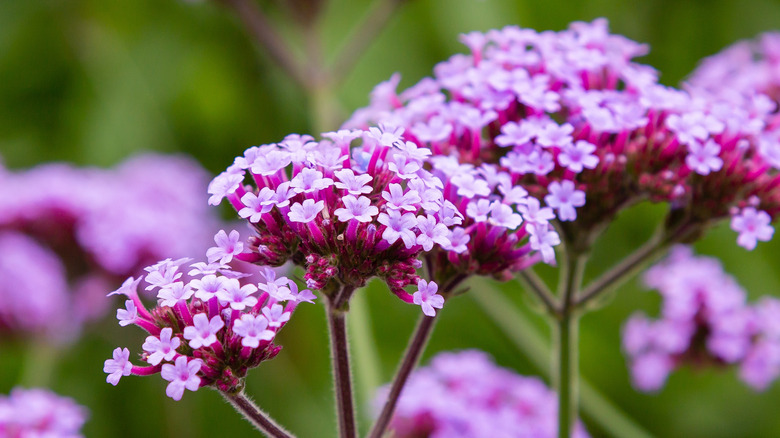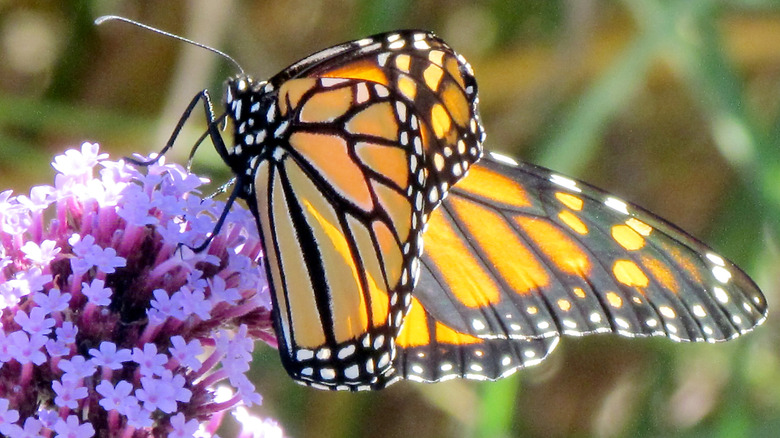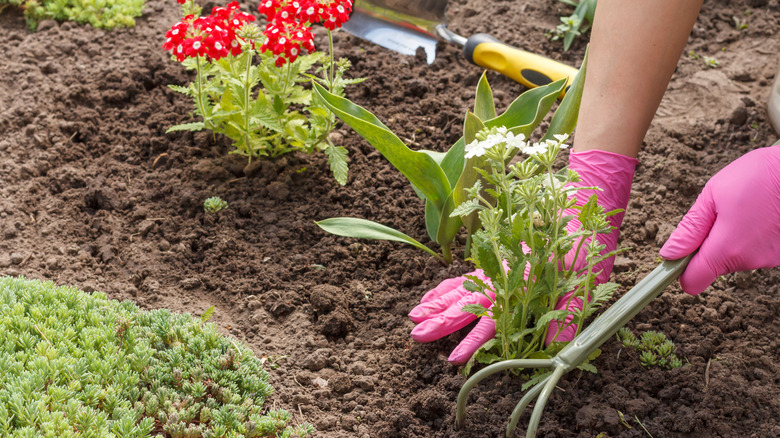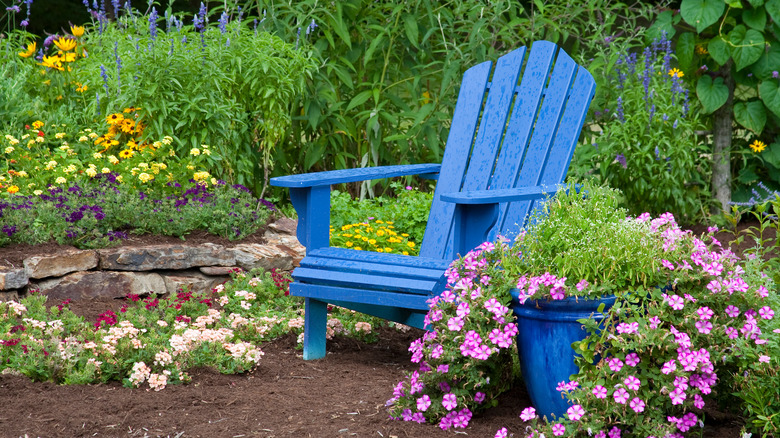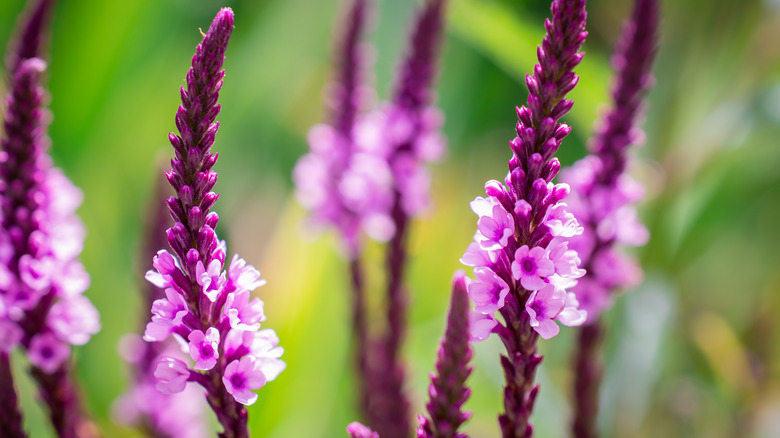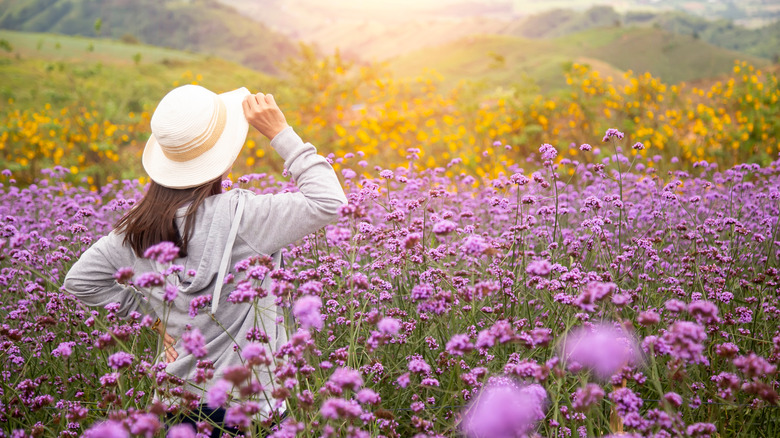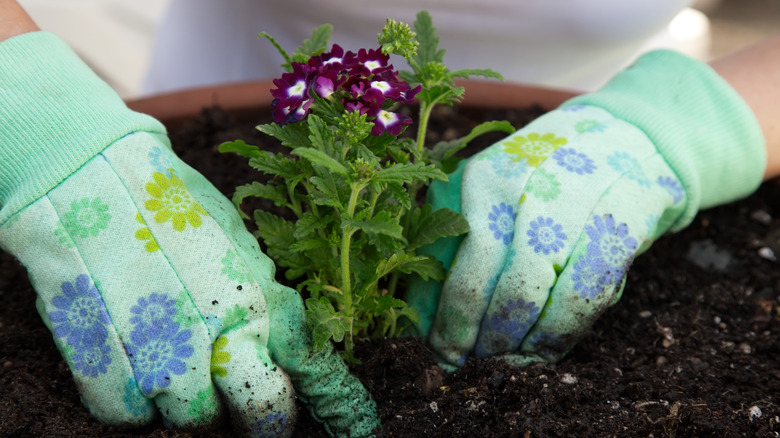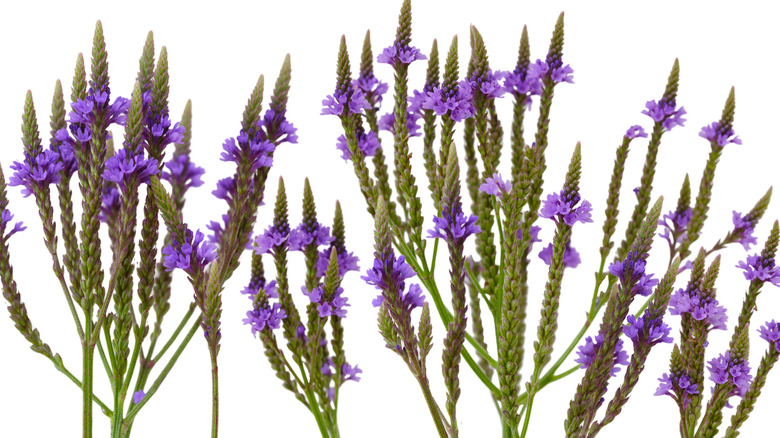Verbena: Everything You Need To Know Before Planting
Generally referred to by their species name (genus Verbena), verbenas are lovely purple flowers that brighten up yards and walkways while attracting pollinators to the garden. Verbena bonariensis (pictured above) is the most commonly known variety, often included in botanical "best of" lists for their delicate beauty combined with an overall toughness that keeps them blooming through long seasons and difficult circumstances.
Purpletop and vervain are other common names for these South American natives that are appreciated for their ability to stand 6 feet tall without ever requiring support stakes. Dengarden says they are drought-tolerant plants that self-seed so often that some people think of them as weeds. We wouldn't dare use such a word to describe something so lovely, and neither would most of the folks who rely on them to flush out their gardens with color year after year.
Note that these purple beauties should not be confused with lemon verbena. Those flowers, used in cooking and to make lemon verbena essential oils for aromatherapy, look a bit different and are an entirely different species within the Verbenaceae botanical family.
How to use verbena plants in a garden
Well-tended verbena plants are incredibly pollinator-friendly, which may be one of their best uses in the garden. Monarch butterflies and bumblebees, in particular, are drawn to verbenas for their sweet scent and abundant nectar. But they're not the only ones who will come check out your garden once they see the verbenas blossoming. Monarch Butterfly Garden offers a long list of pollinators likely to pay a visit that includes honey bees, hummingbirds and hummingbird moths, and a slew of other butterfly species. Their resident gardeners suggest pairing verbenas with milkweed, which is another plant species loved by monarch butterflies.
Purpletop verbena plants have a strong wildflower vibe to them. With that, they can add a dash of height and texture to spice up an otherwise manicured landscape. Because their stalks grow tall, their leaves are small, and their flowers only pop out at the very top of each spike, verbenas maintain a breezy feeling of airiness around them. This makes them a good companion for shorter plants and flowers because they don't block out that all-important sunlight. Verbenas are also known to keep flowering right on into the autumn months, making them a perfect option for filling in areas that would otherwise fall vacant as the season rolls on. What starts out as a pretty violet complement to your early summer bloomers may still be going strong when the chrysanthemums and dahlias arrive.
How to grow verbena plants
Verbenas grow well from seed but taking cuttings is an even easier way to grow new plants, says BBC Gardeners' World Magazine, and the process can be completed in under an hour. Whether you've already got established verbena on your property or you're taking a cutting from a neighbor's stock, first look for the healthiest plants. Do this mid-summer. With a sharp knife in hand, go out early in the day and locate a stem that has shoots growing out from each side. Pick one that doesn't have any flowers on it and make your cut directly below a node (or leaf joint) so that the piece you'll walk away with is about 3 inches long.
Back at your workstation, gently remove all the leaves on the shoot cutting — except for the very top two. Use a small pot filled with compost or high-quality nutrient-dense soil from your garden center. Dipping the cut end of the shoot in a rooting hormone is a good idea with cuttings because it will increase the tiny plant's chance of success. Epic Gardening explains that these hormones come in either liquids, powders, or gels. Once it's dipped, push it gently into the growing medium and give it a soak. A final tip from Gardeners' World is to cover the small pot with a plastic bag and use a rubber band to keep it sealed and in place. Look for root development in six weeks.
How to care for verbena plants
Purpletop vervain flowers can tolerate a significant amount of drought, so, according to the Division of Horticulture at the University of Wisconsin-Madison, if you live in an area with an average amount of yearly rainfall, you won't need to water them. University horticulturists further explain that plants can be shaped early on if you're aiming for less height and more width. Pinching young stems at the point of a leaf node keeps the height of the plant low and convinces it to grow more stems from the pinch point. This in turn creates a bushier plant that may be more appropriate for your landscape.
Deadheading is highly recommended by gardeners in the know. First, there's no reason to settle for one round of blooms at the beginning of the season. Deadheading encourages flowers to blossom again and again throughout the year. Second, verbena are adept self-seeders. Failing to remove spent flower heads could easily result in a garden overrun by little purple flowers popping up everywhere. They might be beautiful at first but their sheer volume is likely to be much more than you bargained for.
Powdery mildew, a fungal disease that collects on leaves, is the only real issue to look out for. Per The Old Farmer's Almanac, the white spots that show up on leaves are unsightly and can slow growth but they don't do a ton of damage. Baking soda or milk mixed with water can be sprayed on leaves in lieu of commercial fungicides.
Verbena plant varieties
There may be over 250 species within the Verbena genus, but there are only a dozen or so that are typically sold. You can find trailing varieties that will grow long and almost vine-like. They look great when planted around the inside edges of a container because they spill over the sides like a waterfall. And then there are upright verbenas, some of which can grow as tall as 6 feet. There are also tiny moss varieties that only grow less than a foot (via Clemson University Cooperative Extension Service). Here are some of the top recommended verbenas to consider for your garden.
-
Verbena rigida: Known as slender vervain, the flowers of this variety of verbena have a more lilac hue. In the Southeast states, you'll find it growing wild in open fields as it has naturalized itself in those areas.
-
Verbena "nana compacta white": Quite similar to the original purple vervain, the nana compacta white offers white flowers that grow to about 8 inches tall.
-
Verbena menthifolia: This California native is an option for folks living in dry climates. Its stems grow tall and thin, and its leaves and flowers stay relatively small.
-
Verbena hastata: Shown pictured above, Verbena hastata has the unfortunate nickname of swamp verbena. It will shoot up to heights of 6 feet and can be found growing naturally in moist locations across the U.S.
-
Verbena simplex: Referred to as a narrowleaf vervain, this variety has lovely clusters of lavender flowers.
Are verbena plants toxic?
Classifying whether verbenas are toxic or not comes with a few caveats and finding consistent information can be difficult. Generally speaking, they are considered relatively safe and have not been included on any major lists of poisonous plants. There have also been some word-of-mouth reports of dogs getting sick after eating them. Quality Dog Resources puts it like this: There are dogs who munch on purpletop verbena and are left none the worse for wear; others not so much. It's important to note that, while it may cause a stomachache, symptoms are highly unlikely to get any more serious.
The tricky part is that different species of plants from the same botanical family can and will have different effects on people and animals when consumed, even if they seem almost indistinguishable at first glance. This absolutely holds true within the Verbenaceae family. Consider these three individual yet related species: Verbena bonariensis (purpletop), Aloysia citrodora (lemon verbena), and Lantana camara (lantanas). The purpletops are considered mostly harmless. The citrus burst of lemon verbena is a well-known and safe additive to cooking and aromatherapy. And the lantana, a very close cousin, should be kept far out of reach of pets because it's definitely poisonous.
The basic takeaway is to use caution. Keep pets out of the garden as much as you can and teach children not to eat anything other than known fruits and vegetables.
How to repot verbena plants
Verbena flowers can make great container plants. If you're going to try to keep them alive year-round, you'll need to bring them indoors, which could very well call for repotting. Perhaps you've had them displayed in a large trough with other summer annuals that finished blooming earlier in the season, or maybe they've made a comfy home cascading down the sides of that hanging basket. Either way, you'll need to get them into something more convenient in order to move them inside. Consider the location you'll be transferring them to — the sunnier the better — and get your potting supplies together.
Per Plant Addicts, verbenas are not fussy when it comes to pots. They'll be just as happy in plastic as they will terracotta. A potting soil that leans slightly toward the acidic side is a great option if it's available. If all you have is a standard mix, though, that will work just as well. Dig wide around the plant to ensure you keep the root ball intact and gently move the entire plant to its new container. If it's early in the season, consider adding a slow-release granular fertilizer at this time. If you're prepping a plant for overwintering indoors, skip it. Give it some water, making sure it drains well, and place it in a bright sunny area that you'll be able to keep consistently warm.
The unexpected benefits of swamp verbena
We've established that some types of verbena are simply ornamental while others can be used in the kitchen. Still, others have proven themselves to be beneficial when ingested medicinally. With a name like swamp verbena, it's hard to imagine wanting to put it anywhere near your mouth, but according to the Lady Bird Johnson Wildflower Center, Verbena hastata has long been used as a folk medicine cure for ailments from depression to fevers and many things in between. Also called American blue swamp vervain, Plants for a Future goes on to claim that, when crushed and inhaled, the plant's dried flower petals can stop a nosebleed.
While also nontoxic just like the purpletop variety, excessive consumption of swamp verbena will probably result in some level of gastrointestinal distress, as is true with almost any plant. Another note of caution when using Verbena hastata medicinally is that it can be contraindicated when combined with hormone therapy or blood pressure medication (per the USDA). Check with your doctor before taking any verbena-based herbal supplements.
